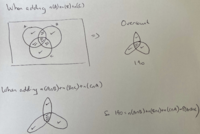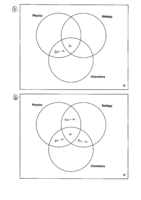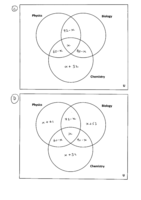Question:
An online survey was undertaken at Gary’s school to find out how many students take at least one Science subject. The following information was collected.
- 380 students are taking Science courses
- 215 taking Biology
- 173 taking Physics
- 182 taking Chemistry
- 72 taking Biology and Physics
- 90 taking Biology and Chemistry
- 60 taking Physics and Chemistry.
Find (?iology ∩ ?hysics ∩ ?hemistry).
Solution:
Correct answer is (? ∩ ? ∩ ?) = 32
Please see here
Issue - can you please explain where the following working goes wrong:
????? ??????? = (215 + 173 + 182) − 380 = 190
190 = (? ∩ ?) + (? ∩ ?) + (? ∩ ?) – 2 × (? ∩ ? ∩ ?)
190 = 72 + 90 + 60 – 2 × (? ∩ ? ∩ ?)
2 × (? ∩ ? ∩ ?) = 222 – 190
2 × (? ∩ ? ∩ ?) = 32
(? ∩ ? ∩ ?) = 16
Many Thanks!!
First read the two previous comments from professional mathematicians.
Let’s analyze your work with basic algebra.
[MATH]\text {Let } a = \text {the number of students who take only biology;}\\
b = \text{the number of students who take only chemistry;}\\
c = \text {the number of students who take only physics;}\\
d = \text {the number of students who take biology and chemistry but not physics;}\\
e = \text {the number of students who take biology and physics but not chemistry;}\\
f = \text {the number of students who take chemistry and physics but not biology;}\\
g = \text {the number of students who take all three science courses.}[/MATH]Seven unknowns.
Those represent numbers in mutually exclusive sets so they can be added without problem. And we are told that the number of students who take a science course is 380. So
[MATH]a + b + c + d + e + f + g = 380.[/MATH] First equation.
And we are told that the number of students who take biology is 215. So
[MATH]a + d + e + g = 215.[/MATH] Second equation.
We are also told that the number of students who take chemistry is 182. So
[MATH]b + d + f + g = 182[/MATH] Third equation.
In addition, we know that the number of students who take physics is 173. So
[MATH]c + e + f + g = 173.[/MATH] Fourth equation.
Plus we know the number who take biology and chemistry is 90. So
[MATH]d + g = 90.[/MATH] Fifth equation.
We also know that the number who take biology and physics is 72. So
[MATH]e + g= 72.[/MATH] Sixth equation.
Finally we know that the number who take chemistry and physics is 60. So
[MATH]f + g = 60.[/MATH] Seventh equation.
We have seven unknowns and seven equations. Solvable.
Have you followed me to here?
Now you went
[MATH](215 + 182 + 173) - 380 = \{(a + d + e + g) + (b + d + f + g) + (c + e + f + g)\} - (a + b + c + d + e + f + g) \implies[/MATH]
[MATH]190 = d + e + f + 2g.[/MATH]
Excellent, you eliminated three variables in one go. But g is in that sum twice.
Then you went
[MATH]90 + 72 + 60 - 190 = \{(d + g) + (e + g) + (f + g)\} - (d + e + f + 2g) \implies[/MATH]
[MATH]32 = (d - d) + (e - e) + (f - f) + (3g - 2g) \implies 32 = 2g \implies g = 16. [/MATH]
But that of course is an error. 3g - 2g = g so g = 32, not 16. I think you recognized that the one sum contained g three times, but did not recognize that the other sum contained g two times. You thought (because you did not actually do the algebra) that the other sum contained g only once. So you subtracted 3g - g = 2g. That was your conceptual error.
Now let me go back to the post of pka, who has taught combinatorics at the university level. His point is that if you fully understand the inclusion-exclusion principle, you can avoid all this basic but tedious and error-prone algebra.
In his notation, my g was included in B and C and P (counted 3 times). My g was also included in B union C, B union P, and C union P (counted 3 times). When those two sums were subtracted, g was not counted at all so it must be added in to get the proper total. That is, his X is my g. Getting his point will save you a lot of time and avoid many errors.You can solve these problems with simple algebra, but why bother.
With respect to Venn diagrams, I have never found them helpful in solving counting problems. They are, however, very helpful in demonstrating solutions to counting problems and to gaining an intuitive understanding of the inclusion-exclusion principle.



